I hope you have had a good Christmas in whatever form that may have taken in these strange times. As well as Christmas, last week also saw the shortest day of the year, and slowly the days will start to lengthen. The weather has also been very grey and cloudy and the period between Christmas and New Year is often a good time to get out for a walk.
The Thames Estuary is an ideal place for a walk. Close to the Thames and the sea, usually a good breeze to blow away any late December lethargy, and plenty of historic places to explore.
One of these is the ancient church of Reculver on the north Kent coast. The remains of a church built in an old Roman camp, with two distinctive towers that for long were navigation markers for those sailing on the estuary.
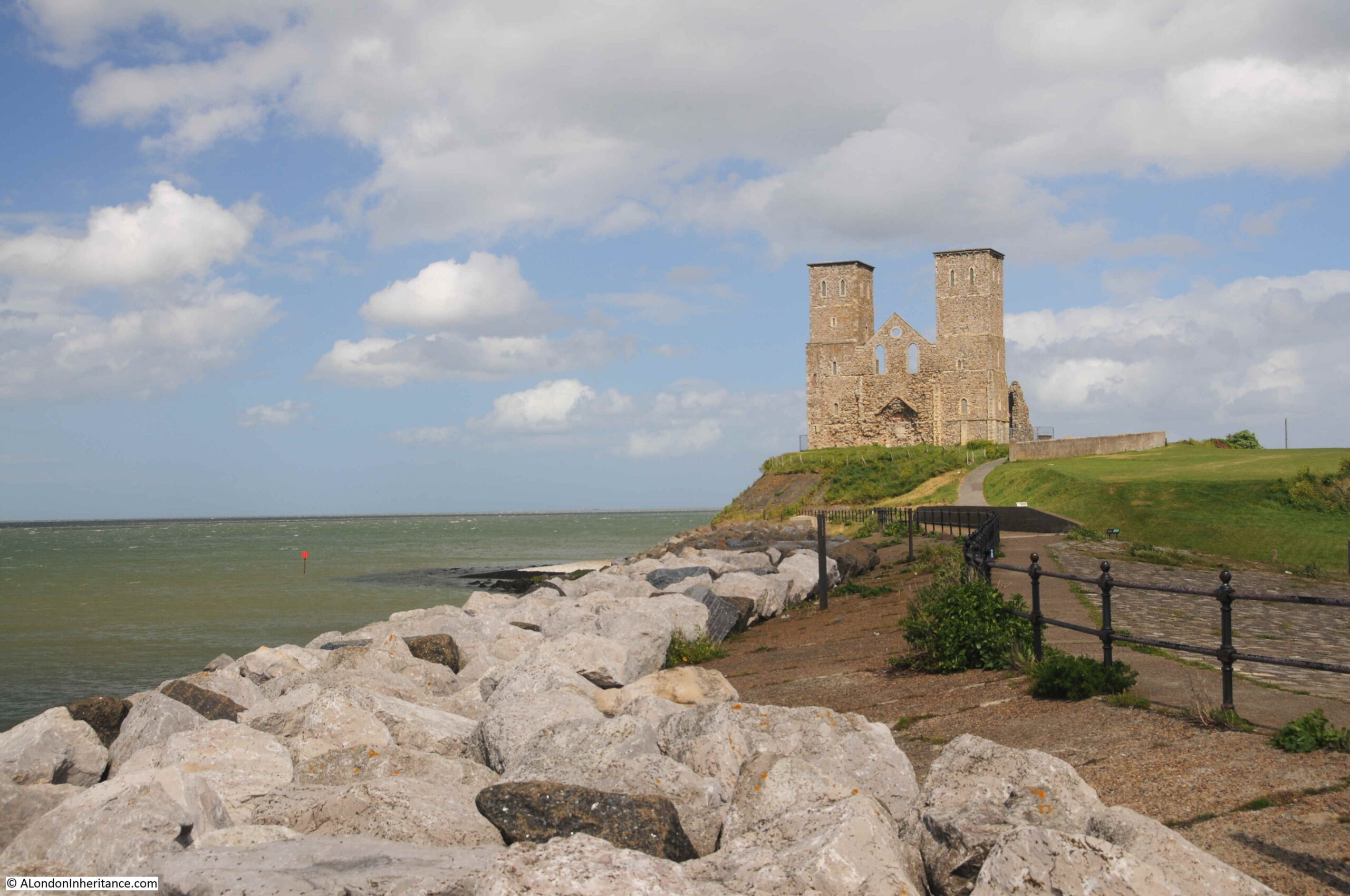
Reculver is a few miles to the east of Herne Bay, and as the above photo shows is on a prominent location on a cliff top next to the sea. The location is ringed in the following map ( © OpenStreetMap contributors):

This has long been an important location, with the first major construction on the site being an early Roman fort. A Saxon church was built at some point around the year 669, with the church forming the core of a small monastic settlement.
The towers were added when a series of alterations were made to the church at the end of the twelfth century. This work included a new, large west facing doorway.
The church was built in the centre of the original Roman fort, and the church was originally almost a mile from the sea, however erosion has taken the sea up to the edge of the church, and the land occupied by almost half of the Roman fort has been lost.
The beach (now occupied by large rocks to prevent further erosion) and the church has long been a tourist destination, and the following early postcard shows what would have greeted visitors in the early 20th century:
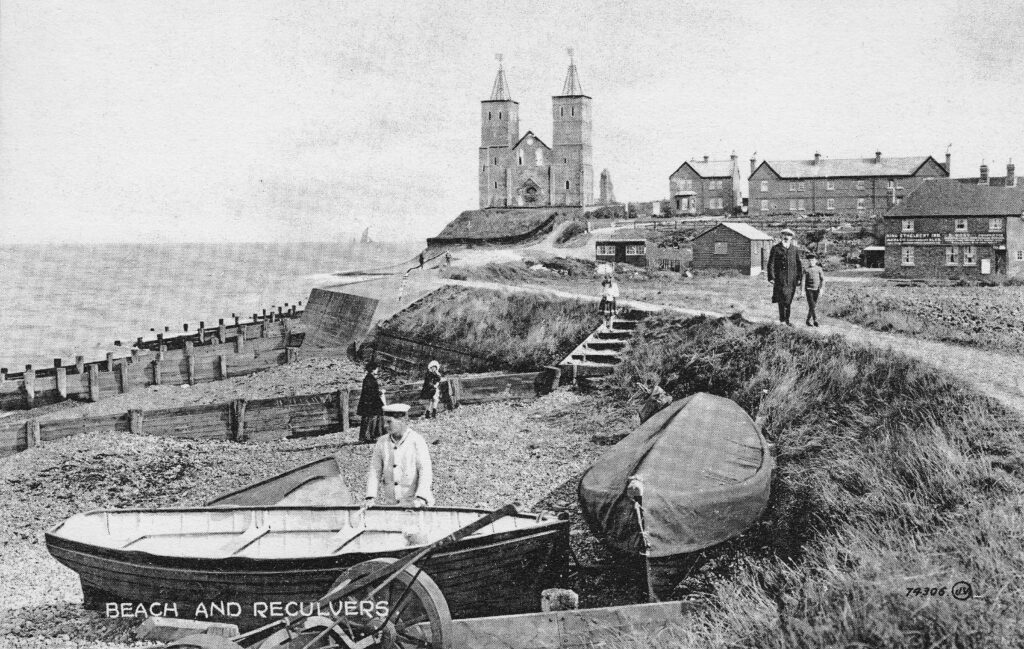
The Monastic establishment came to an end in the year 949 when the building took on the role of a parish church. The rebuild of the late twelfth century utilised the remains of the old monastery to construct the new church.
Over the centuries, land was gradually being eroded, and by 1780, the northern corner of the church was only 50 yards from the sea. In 1802 much of the core of the church collapsed and by 1805, the two towers were at risk.
The prominence of the two towers, on the cliff, overlooking the sea and the Thames estuary was critical to navigation. The minutes of Trinity House from 1662 record the need to make repairs to the steeples of a building that was long regarded as an “ancient sea mark”.
With the two towers at risk in 1805, Trinity House took action and purchased the remains of the old church in 1810 and built groins along the beach in front of the cliff, to break up the action of the waves. They also faced the cliff with stone to prevent further erosion, and following this work, the two towers have been able to continue to help those navigating at sea.
Trinity House also rebuilt the wooden steeples at the top of the towers, which had been blown down (it can get very windy along this exposed coast).
Navigation markers, such as the towers at Reculver, were becoming less relevant in the early 20th century for navigation on the Thames estuary, so Trinity House handed over the site to the Government’s Office of Works in 1925, and it is now the responsibility of English Heritage.
The following print from 1834 shows the new wooden steeples installed by Trinity House at the top of the towers. Note also to the right of the church two structures with flags which were probably used for signaling to ships at sea (© The Trustees of the British Museum).
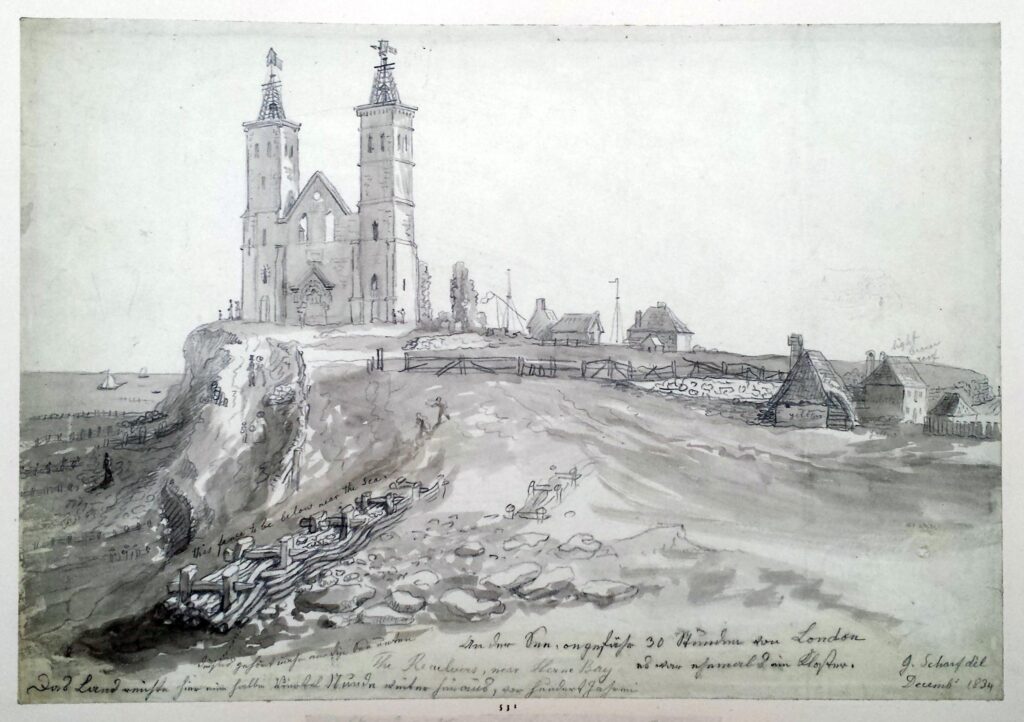
Getting closer to the church and the original west facing entrance can be seen, now blocked up.
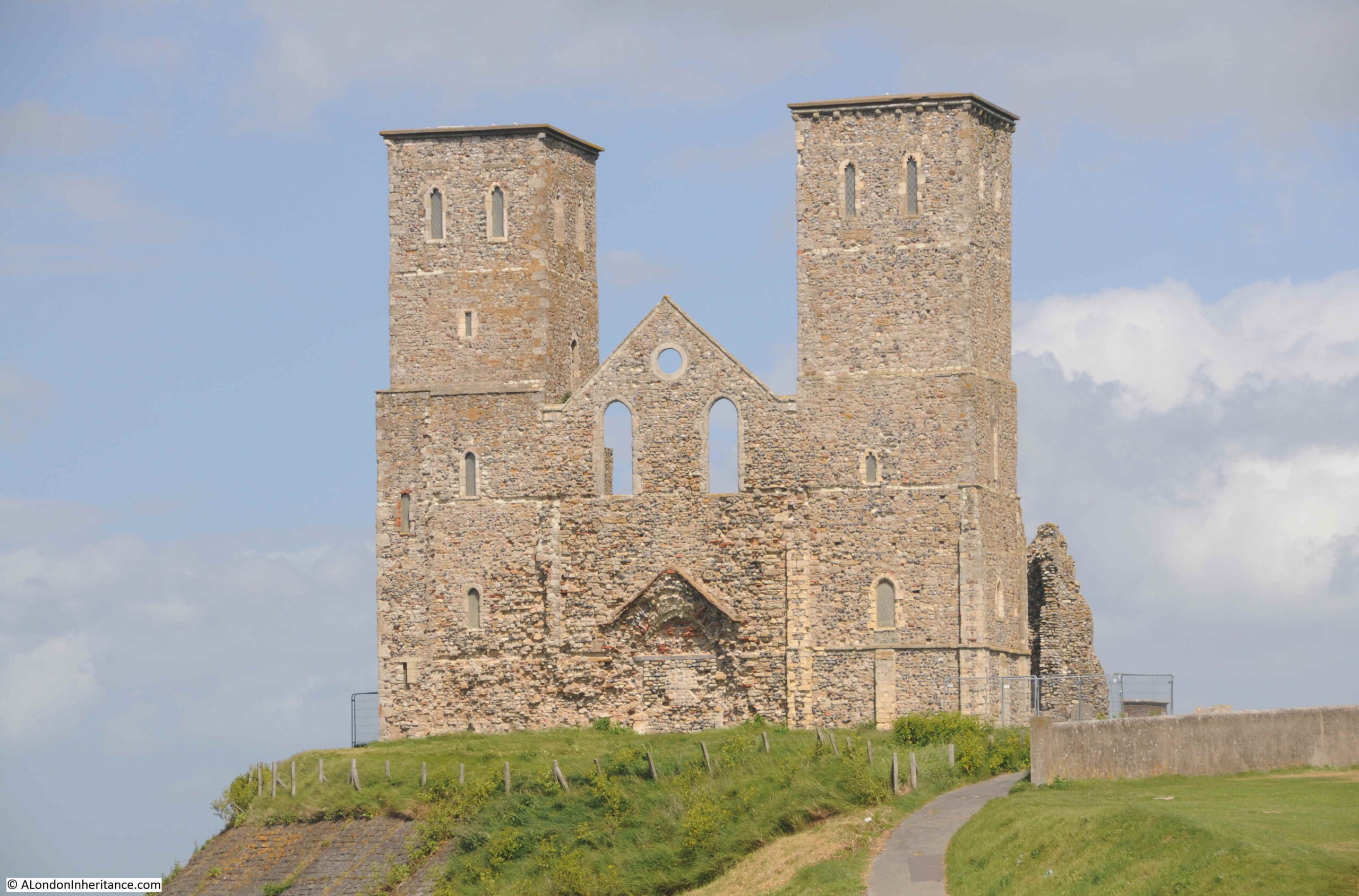
A legend associated with the twin towers of the church is that they were either caused to be built, or where repaired around the year 1500 by Frances St. Clair, Abbess of a Convent of Benedictine Nuns at Davington.
There are a number of variations to the legend, with the majority recording that Frances, along with her sister (also a nun) were travelling on a ship that was shipwrecked near Reculver. They were brought ashore at the church. Some variations record that her sister Isabelle died in the ship wreck, other that they were both saved.
Either way, due to the shipwreck, Francis had the towers built / repaired as a result of being saved, or in memory of her sister.
A drawing from 1784 shows Frances and Isabella being reunited in front of the church at Reculver, with some serious artistic license and creativity being used to show the buildings of the church in the background (© The Trustees of the British Museum).

The site of the church has probably been in use for well over 2,000 years. Archaeological excavations have shown that the Roman fort probably started as a small initial camp for the invading Roman forces in the year 43. Excavations have also revealed that Reculver was the site of an earlier Iron Age farmstead.
The site was occupied throughout the Roman period, and the main walled fort was built early in the third century. It became one of the line of forts known as the Saxon Shore Forts which were established along the eastern and southern coast of England, and the northern coast of France, in the late third century, to protect against raiding parties as the Roman empire started to face many of the threats that would result in Rome abandoning England in the early 5th century.
The remains of a number of the walls of the fort can still be seen around the site, and Roman tiles and stone were used in the construction of the church. The distinctive red / orange Roman tiles can be seen embedded in many of the remaining walls of the church:
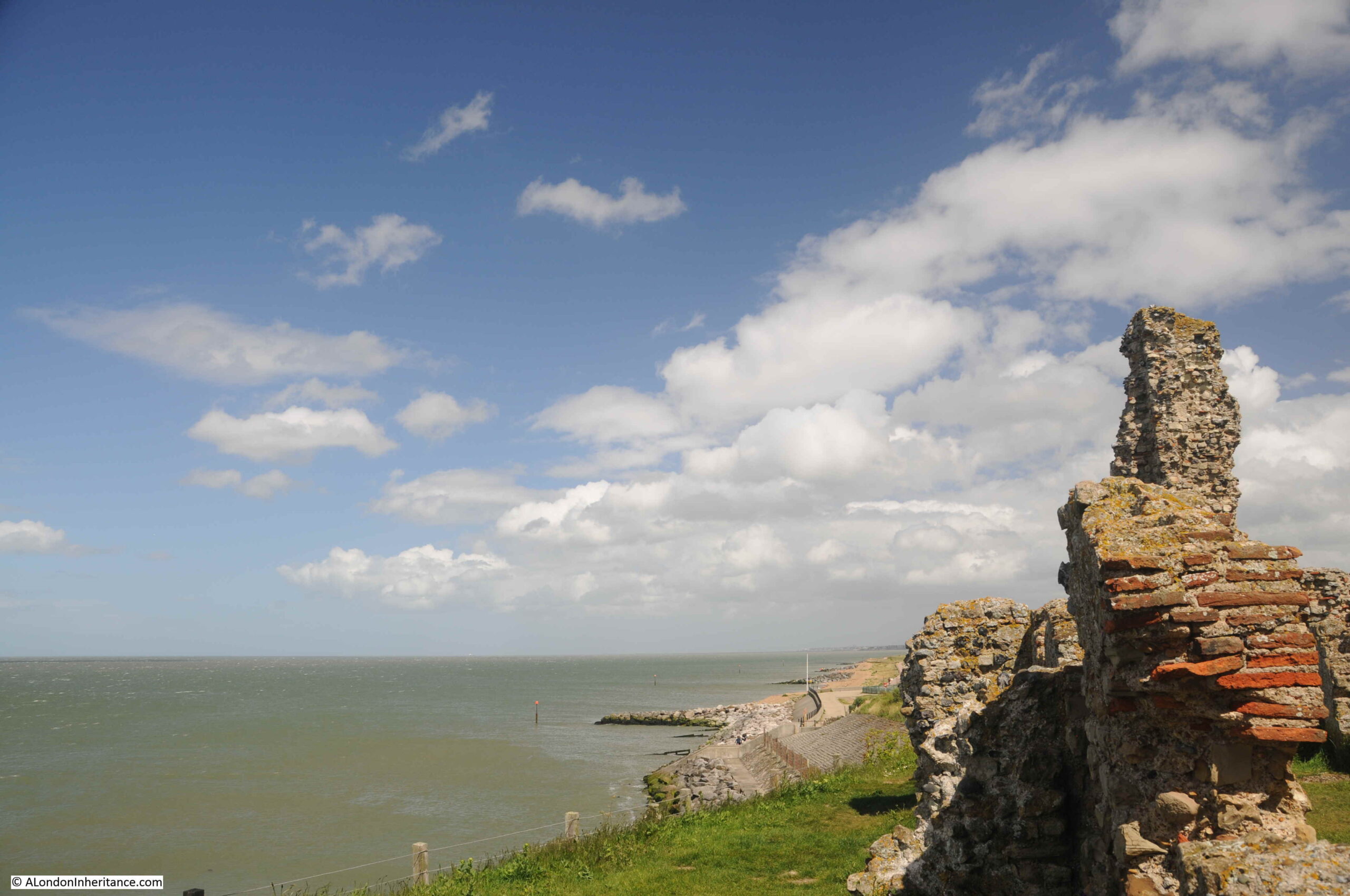
My last visit to Reculver was on a brilliant sunny day, and the ruins of the church stood out against a blue sky.
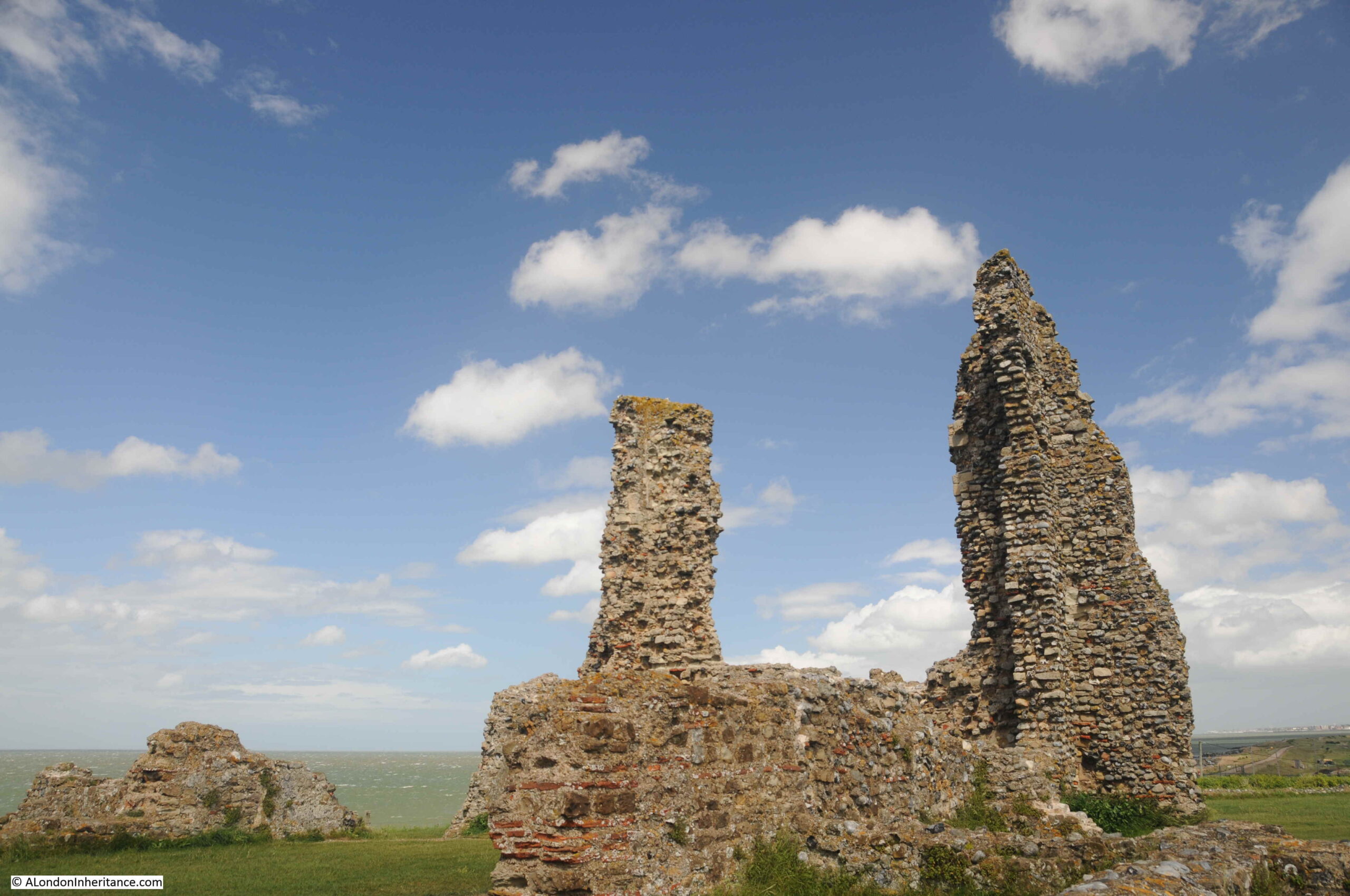
However it is a wonderful place to walk at any time of year, and has frequently been illustrated as part of a windy / stormy scene with the waves crashing up to the cliff showing how easily this part of the north Kent coast is eroded, and that the church would have been victim to the waves if not for the work of Trinity House. The following print is from 1829 (© The Trustees of the British Museum):
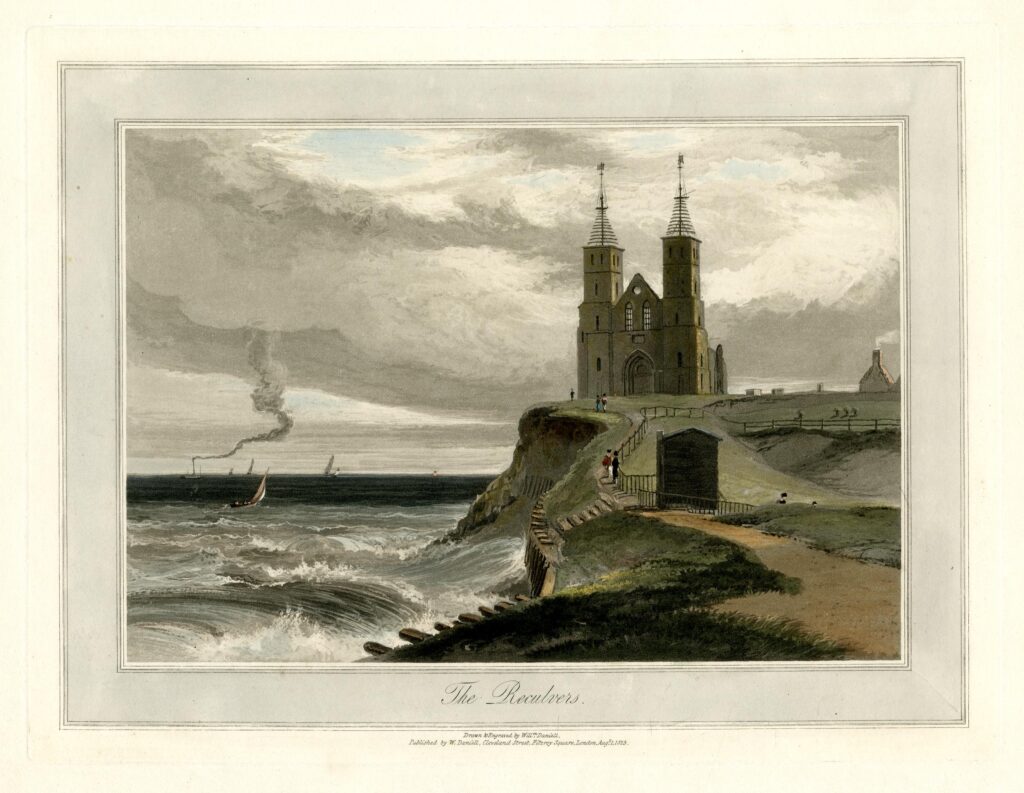
Another scene from 1796 showing the nave of the church before this collapsed in 1802. The scene also shows a house between church and cliff, however as well as the collapse of the church, a few years later this house would also be lost and the cliff would be up against the church (© The Trustees of the British Museum).
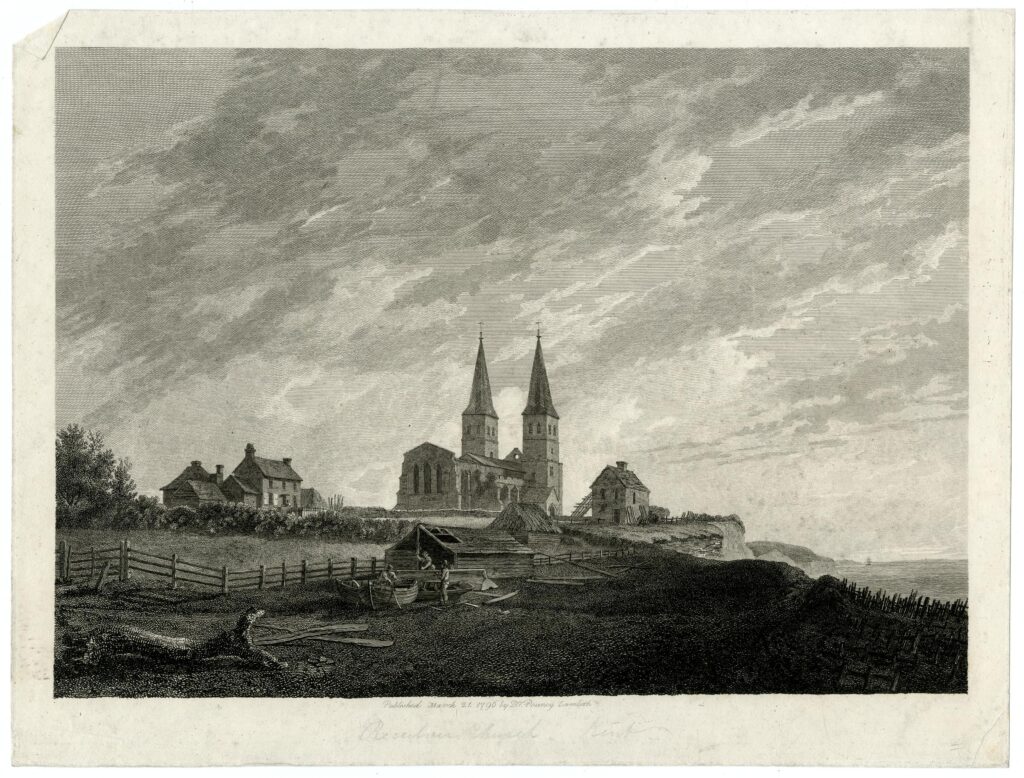
Whilst today there are very few sailing ships off Reculver using the towers as navigation markers, the view from Reculver includes the Kentish Flats wind farm, roughly six miles offshore, and in the middle of the following photo, just visible on the horizon, is the Red Sands fort:

Reculver is a fascinating place to visit at anytime of year. It is also a good place to see the impact of coastal erosion, with getting on for a mile of land having been lost in recorded history. Without the work of Trinity House, it is doubtful whether the two towers, the remains of the body of the church, and some of the walls of the Roman fort would remain for us to see today.
That’s my last post for 2021. Thanks for reading over the last year, and can I wish you all a very happy and healthy 2022.

Thank you so much for your scholarly yet personal postings this year which are enjoyed enormously.
Wishing you and your family all the very best for 2022.
Look forward to many more.
Entries are always of interest.
Thank you for another year of delights. Every Sunday morning, I fire up the laptop, sit with my coffee and wait to be intrigued. I hope you had a fine Christmas and that 2022 finds you in hale and hearty.
Many thanks for the last post of the year, always interesting.
Wishing you all the best for the New Year.
Thank you so much for all your hard work, it’s greatly appreciated.
I hope you had a wonderful Christmas. Wishing you a happy new year.
All the best for you in 2022, looking forward to more walks.
Another interesting Sunday post. A Happy New Year 2022 to you and your other readers.
Thanks again for another informative post. I recall reading that the roman Fort was built on the entrance to the Wansum channel, which at that time made Thanet a proper island.
I always enjoy your posts – some areas are familiar, others not, but all are intriguing. Thank you for all your hard work in researching these areas.
Let’s hope 2022 will bring less worry and more good times for us all. Happy new year !
season’s greetings – Reculver (and nearby coast) also the site of the Barnes Wallis trial runs – perhaps you’ve covered this before?
the view at night is really something, especially in the moonlight.
very much enjoy your recondite info on London sites – I look forward to next year’s ….
best wishes
K
Fascinating, my childhood holidays were always spent at either Leysdown, Sheerness, Herne Bay but I don’t recall ever going to Reculver.
Happy and healthy New year to you.
Great article – thanks! I think a couple of days walking from Whitstable to Herne Bay and Reculver might be something to cheer up January 🙂
I was interested in the third photo with the caption ‘Beach and Reculvers’. Does the plural have any significance?
What an excellent piece – as ever. I often wonder if there wasn’t a matching but lost fort off Foulness, accessed by the broomway. With a couple of galleys in each you could control the Thames. A couple more at Bradwell would control approaches to Colchester. Have a good year to come
Thank you for all your posts, which my wife and I both enjoy. These have led us to explore parts of London, previously unknown to us. Happy New Year!
Merry Christmas and Happy New Year!
Thank you for another fascinating post with many details I`d forgotten having spent many visits to Reculvar in the 1960`s and 70`s as a child and adult as my grandparents lived just outside Herne bay at Broomfield.
Happy New year and looking forward to more of your very interesting research in 2022.
Thanks for this interesting post. Back in the fifties my family often visited my mum’s aunts, who lived at Herne Bay, on the Beltinge side. We sometimes walked to Reculver, but I did not know any of this history.
Best wishes for 2022, and I look forward to reading more of your posts.
Thank you for another fascinating read, just the thing on a cold a wet windy morning.
i shall look forward to further articles and wish you a Merry Christmas and a Happy and
Healthy New Year.
As always another fascinating and infornative post about something I’d now like to go and explore myself. I really enjoy reading your posts, so thank you very much and I wish you a very happy & safe new year.
As always another fascinating and infornative post about something I’d now like to go and explore myself. I really enjoy reading your posts, so thank you very much and I wish you a very happy & safe new year.
When the pandemic has calmed down, I hope to be able to return to London for vacation. In the meantime, your posts give me ideas for future walks as well as an escaping from pandemic NYC.
Have a great New Year!
Interesting as ever. Great stuff. Ian Fleming knew this part of the world well. In the book Goldfinger has his factory at Reculver. Moonraker is set nearby at Kingsdown. The film versions use more exotic locations.
I enjoy your articles every Sunday with my morning cuppa; today’s was no exception. Thank you for all of your hard work and research; you have caused me to purchase more books than you could guess! Wishing you Happy Holidays, and a brighter (and hopefully calmer) 2022. All the Best!
Happy New Year, and thanks for the terrific Sunday morning reads.
Thank you for another enjoyable year of posts. I wish you a very Happy and healthy New Year
Many thanks for another year of fascinating stuff! And a Happy New Year to you and yours.
I enjoyed this article. It’s not somewhere I’ve ever been nor heard of but what a picturesque setting. Thank you for sharing.
Thank you for brightening my Sunday mornings for another year. I can’t wait to see what you uncover in 2022.
Very interesting post, as ever. Thank you for your work over the year and look forward to more posts.
Thanks for all your fascinating posts. Some have brought new knowledge to areas I know well and others have gone on a list to visit in the future. I lived in Westgate on Sea when I studied at Kent University and the Reculver towers were visible from the beach. I loved walking round the area but remember some howling gales and spraining my ankle by tripping over an ancient stone!
Another year of enjoyable Sunday morning reads, and now with guided walks, too. Best wishes for another year of the same.
I echo all the above comments. I remember, and have photos somewhere of family visits to Reculver.
Looking forward to my Sunday morning reads in 2022.
Happy New Year to you and your family
Many thanks for this and all the fascinating posts over the past year. Best wishes for the New Year!
Wishing you and yours a happy New Year- many thanks for the Sunday institution that is A London Inheritance.
Thankyou for your detailed and very well-written posts over the last year – I always look forward to a Sunday afternoon read whilst the kids are occupied after lunch.
A very happy new year to you too and long may your excellent blog continue!
Happy New year. Interesting post as usua
I’ve just moved from South London to Faversham, so this post was a welcome surprise! A wonderful walk along the Saxon Shore path it always is. My grandparents lived in Birchington once upon a time so I have some happy summer memories there as a child.
Many thanks for your posts and a happy new year to you. I came across your blog a number of years ago now and it’s become a built in habit to check for a new post each week!!!
Looking forward to future blogs in the new year -have a good new year
Thank You for your scholarly and immaculate presentations through the year…One further comment to
make about Reculver,it’s a pretty good place for bird watching….Happy New Year…
Many thanks for a very interesting and informative year of London Inheritance. I have lived in London nearly all my life and never knew there were such fascinating places of interest.
Looking forward to 2022.
Wishing you and your family a very Happy New Year.
Thanks for this lovely post, this blog is a real help to me, being separated from my beloved London by Covid.